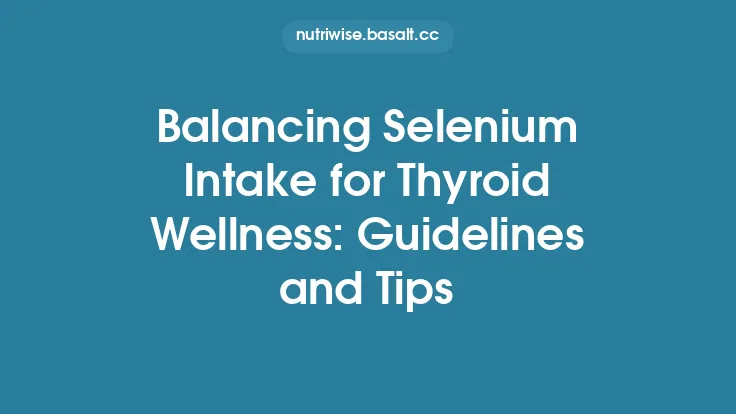Vitamin A is a cornerstone micronutrient for ocular physiology, yet its benefits are realized only when intake is carefully calibrated to meet the eye’s long‑term demands without tipping into excess. Striking this balance involves understanding the body’s regulatory mechanisms, the distinct forms of vitamin A in the diet, individual variability in requirements, and the potential consequences of both deficiency and over‑consumption. This article explores the nuanced considerations that enable sustained eye health through a well‑managed vitamin A intake plan.
Understanding the Balance: Why Moderation Matters
The retina, cornea, and lacrimal glands each rely on vitamin A for specific cellular processes—phototransduction, epithelial maintenance, and mucin production, respectively. However, the eye’s demand for vitamin A is modest compared to the total body pool, and the nutrient is stored primarily in hepatic stellate cells. When intake exceeds the liver’s storage capacity, retinol can accumulate to toxic levels, leading to systemic and ocular side effects. Conversely, chronic marginal intake can deplete hepatic reserves, subtly impairing visual function over years. Thus, the goal is to maintain a steady, physiologically appropriate supply that supports ocular tissue turnover while avoiding hepatic overload.
Recommended Dietary Allowances and Upper Intake Levels
International nutrition bodies converge on a narrow window for safe vitamin A consumption. The Institute of Medicine (now the National Academy of Medicine) sets the Recommended Dietary Allowance (RDA) for adults at 900 µg retinol activity equivalents (RAE) for men and 700 µg RAE for women per day. The Tolerable Upper Intake Level (UL) is established at 3,000 µg RAE/day for adults. These values incorporate both preformed retinol (from animal sources and supplements) and provitamin A carotenoids (from plant foods), the latter being converted to retinol with an efficiency factor of 12 µg β‑carotene ≈ 1 µg RAE.
For long‑term eye health, staying within 80–120 % of the RDA is generally sufficient. Exceeding the UL, especially through high‑dose retinol supplements, markedly raises the risk of hypervitaminosis A, a condition that can manifest with ocular symptoms such as blurred vision, increased intraocular pressure, and, in severe cases, optic neuropathy.
Retinol vs. Provitamin A Carotenoids: Bioavailability and Metabolism
Vitamin A exists in two principal dietary forms:
- Preformed retinol – found in liver, dairy, and eggs; absorbed as a micelle‑soluble lipid and directly incorporated into chylomicrons.
- Provitamin A carotenoids – such as β‑carotene, α‑carotene, and β‑cryptoxanthin; absorbed similarly but require enzymatic cleavage by β‑carotene 15,15′‑dioxygenase (BCO1) in the intestinal mucosa to generate retinal, which is then reduced to retinol.
The conversion efficiency of carotenoids is highly variable, influenced by genetic polymorphisms in the BCO1 gene, dietary fat content, and the food matrix. For individuals with reduced conversion capacity, reliance on preformed retinol may be necessary to meet ocular needs without excessive carotenoid intake. Conversely, those with efficient conversion can safely meet their RDA through carotenoid‑rich plant foods, which also provide antioxidant co‑nutrients that support retinal health.
Potential Risks of Excessive Vitamin A
Hypervitaminosis A can be acute (from a single massive dose) or chronic (from sustained intake above the UL). Ocular manifestations include:
- Increased intracranial pressure leading to papilledema and transient visual obscurations.
- Dry eye syndrome due to altered meibomian gland secretion.
- Retinal toxicity characterized by photoreceptor degeneration in animal models, though rare in humans.
Systemic toxicity may present with hepatomegaly, bone demineralization, and teratogenic effects in pregnancy. Because the liver is the primary storage site, regular monitoring of hepatic function tests is advisable for individuals on high‑dose retinol supplementation.
Assessing Individual Needs: Age, Sex, Health Status
While the RDA provides a baseline, several factors modulate vitamin A requirements for eye health:
- Age – Older adults experience reduced intestinal absorption efficiency and may benefit from modestly higher intake within safe limits.
- Sex – Women generally have lower RDA values, but hormonal fluctuations (e.g., during pregnancy) increase demand.
- Metabolic conditions – Fat malabsorption syndromes (celiac disease, cystic fibrosis) impair retinol uptake, necessitating tailored supplementation.
- Genetic variants – Polymorphisms in BCO1 and retinol‑binding protein (RBP) genes can affect conversion and transport, respectively.
A personalized assessment, ideally conducted by a registered dietitian or clinician, should incorporate dietary history, health status, and, when indicated, laboratory markers.
Guidelines for Supplementation and Food Fortification
When dietary intake alone cannot meet the RDA, supplementation should follow these principles:
- Prefer low‑dose, split‑regimen formulations (e.g., 500 µg RAE twice daily) to mimic physiological absorption patterns.
- Choose mixed‑source supplements that combine retinol with β‑carotene, allowing the body to self‑regulate conversion based on need.
- Avoid mega‑doses unless prescribed for a specific clinical indication (e.g., severe deficiency under medical supervision).
- Consider fortified foods (e.g., vitamin A‑enriched margarine) as a gradual source, ensuring the fortification level does not push total intake near the UL.
Monitoring Vitamin A Status: Biomarkers and Clinical Indicators
Accurate assessment of vitamin A status is essential for long‑term management:
- Serum retinol concentration – The gold standard; values <0.70 µmol/L suggest deficiency, while >2.5 µmol/L may indicate excess.
- Retinol‑binding protein (RBP) – Correlates with serum retinol but can be confounded by protein‑energy malnutrition.
- Liver biopsy – Direct measurement of hepatic stores, reserved for research or severe cases.
- Functional ocular tests – While not primary diagnostic tools for vitamin A balance, periodic evaluation of tear film stability and corneal epithelial integrity can provide early signals of imbalance.
Regular monitoring (e.g., annually for at‑risk groups) helps maintain intake within the optimal window.
Interactions with Other Nutrients and Medications
Vitamin A metabolism does not occur in isolation:
- Vitamin E and C – Antioxidants that protect retinol from oxidative degradation, enhancing its efficacy in ocular tissues.
- Zinc – A co‑factor for the synthesis of retinol‑binding protein; zinc deficiency can impair retinol transport, necessitating concurrent zinc intake.
- Alcohol – Chronic consumption induces hepatic cytochrome P450 enzymes that accelerate retinol catabolism, increasing the risk of deficiency despite adequate intake.
- Isotretinoin and other retinoids – Pharmacologic retinoids can potentiate vitamin A toxicity; concurrent supplementation should be avoided or strictly supervised.
Understanding these interactions enables clinicians to adjust vitamin A recommendations in the context of broader nutritional and pharmacologic regimens.
Practical Strategies for Sustainable Intake
Achieving a balanced vitamin A profile for eye health can be integrated into everyday life:
- Meal composition – Pair vitamin A‑rich foods with a modest amount of dietary fat (e.g., avocado, olive oil) to enhance absorption.
- Portion control – A single serving of liver (≈3 oz) provides >5 × the RDA; limit to once a week to avoid excess.
- Diverse sources – Rotate between animal‑based retinol (e.g., eggs, dairy) and plant‑based carotenoids (e.g., sweet potatoes, carrots, kale) to benefit from both forms.
- Supplement timing – Take low‑dose retinol supplements with meals containing fat, and avoid taking them on an empty stomach.
- Record keeping – Use a nutrition tracking app to log vitamin A intake, ensuring cumulative daily totals remain within the 80–120 % RDA range.
Special Considerations for Vulnerable Populations
Certain groups require heightened vigilance:
- Pregnant and lactating women – While increased vitamin A is essential for fetal development, the UL is lower (2,800 µg RAE/day) due to teratogenic risk; emphasis on carotenoid sources is advisable.
- Children – Their UL is proportionally lower; excessive retinol can impair growth. Age‑appropriate fortified foods and pediatric‑formulated supplements are preferred.
- Elderly with polypharmacy – Drug‑induced alterations in hepatic metabolism may necessitate periodic reassessment of vitamin A status.
- Individuals with chronic liver disease – Impaired storage capacity heightens toxicity risk; supplementation should be minimal and closely monitored.
Future Directions in Research and Public Health
Emerging evidence suggests that the relationship between vitamin A and ocular longevity extends beyond simple adequacy:
- Genomic profiling – Large‑scale studies are identifying SNPs that predict individual conversion efficiency, paving the way for genotype‑guided dietary recommendations.
- Nanocarrier delivery systems – Encapsulation of retinol in liposomal or polymeric nanoparticles may improve bioavailability while reducing hepatic load, offering a novel avenue for safe supplementation.
- Population‑level fortification policies – Ongoing debates balance the need to prevent deficiency in low‑income regions against the risk of excess in high‑intake societies; refined fortification standards based on regional dietary patterns are under development.
- Longitudinal ocular outcome trials – Prospective cohorts tracking vitamin A intake, serum biomarkers, and detailed ophthalmic imaging will clarify the optimal intake window for preserving retinal structure and function over decades.
Continued interdisciplinary collaboration among nutrition scientists, ophthalmologists, and public‑health policymakers will be essential to translate these insights into practical guidelines that safeguard eye health across the lifespan.
By appreciating the delicate equilibrium between sufficiency and excess, individuals and health professionals can craft evidence‑based strategies that support the eye’s intricate architecture for years to come. Balanced vitamin A intake—anchored in personalized assessment, prudent supplementation, and mindful dietary choices—remains a cornerstone of sustainable ocular wellness.





